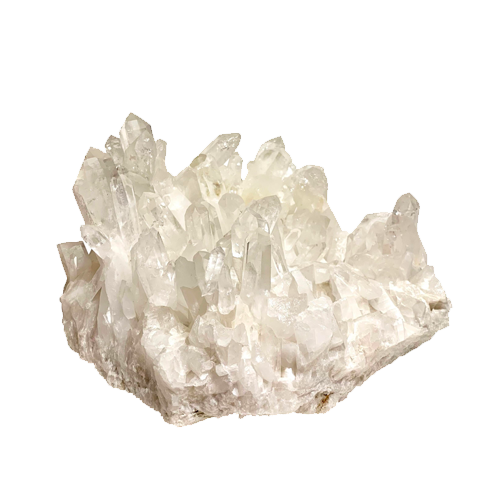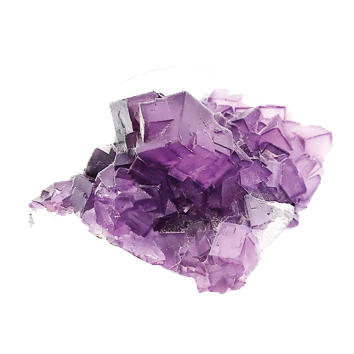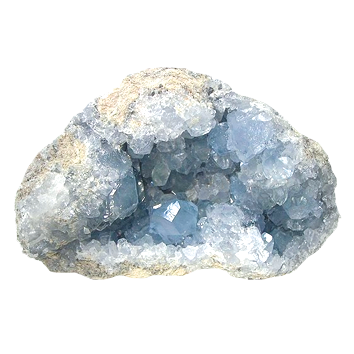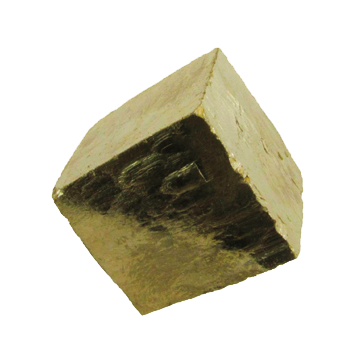GEOLOGY 101
Mineral Groups ◎
Almost 99% of the Earth’s crust is made up of only eight elements – oxygen, silicon, aluminium, iron, calcium, sodium, potassium, & magnesium – & these are the elements that make up most minerals. All minerals have a specific chemical composition & chemical formula. For example, the mineral silver is made up of only silver atoms (Ag) & diamond is made only of carbon atoms (C), but most minerals are made up of chemical compounds, like Calcite which contains carbon, oxygen, & calcium (CaCO3). Minerals can be divided into groups based on chemical composition & most minerals fit into one of eight mineral groups:

Native Elements
Native elements contain only atoms of one type of element. There are very few examples of these types of minerals, & they are often rare & valuable. Examples include Gold (Au), Silver (Ag), Sulfur (S), Graphite (C) & Diamond (C).

Silicates
Silicates are the largest & most common mineral group, making up over 90% of the Earth's crust. They contain one silicon atom bonded with four oxygen atoms, creating a tetrahedron, which is the building block of all silicate minerals. Most silicates contain other elements such as calcium, iron, & magnesium. Examples include Quartz (SiO2) & Olivine ((Mg,Fe)2SiO4).

Carbonates
All carbonates contain one carbon atom bonded to three oxygen atoms. Carbonates may include other elements such as calcium, iron, & copper. Examples include Calcite (CaCO3), Malachite (Cu₂CO₃(OH)₂) & Azurite (Cu3(CO3)2(OH)2).

Halides
Halide minerals are salts that usually form when salt water evaporates. They may contain elements such as fluorine, chlorine, bromine, or iodine, & may sometimes combine with metal elements. Common table salt, Halite, is a halide mineral that contains the elements chlorine & sodium. Other examples include Fluorite (CaF2) & Atacamite (Cu2Cl(OH)3).

Oxides
Earth’s crust contains a lot of oxygen & this oxygen can sometimes combine with other elements to create oxide minerals. Oxides contain one or two metal elements combined with oxygen. They differ from silicates as they do not contain silicon. Examples include Hematite (Fe2O3), Magnetite (Fe2O4) & Rutile (TiO2).

Phosphates
In phosphates, an atom of phosphorus, arsenic, or vanadium is bonded to oxygen. There are many types of phosphate minerals, but they are rare & often complex in composition. Examples include Apatite (Ca5(PO4)3(F,Cl,OH)) & Turquoise (CuAl₆(PO₄)₄(OH)₈ • 4H₂O).

Sulfates
Sulfate minerals contain sulfur atoms bonded to oxygen atoms. Like halides, they form where salt water evaporates. The sulfate group contains many different minerals, but only a few are common. Examples include Gypsum (CaSO4·2H2O) & Celestite (SrSO4).

Sulfides
Sulfides are formed when metallic elements combine with sulfur. Unlike sulfates, sulfides do not contain oxygen. Examples include Galena (PbS) & Pyrite (FeS2).
-
Rose Quartz (Gemmy + Pale Pink!) Raw
Regular price $4.50 AUDRegular price -
'Birthday' Wish Candle Bundle - 6 for $8.00
Regular price $8.00 AUDRegular price -
Rose Quartz Tumble
Regular price $3.50 AUDRegular price -
Pink Opal Tumble
Regular price $9.50 AUDRegular price




